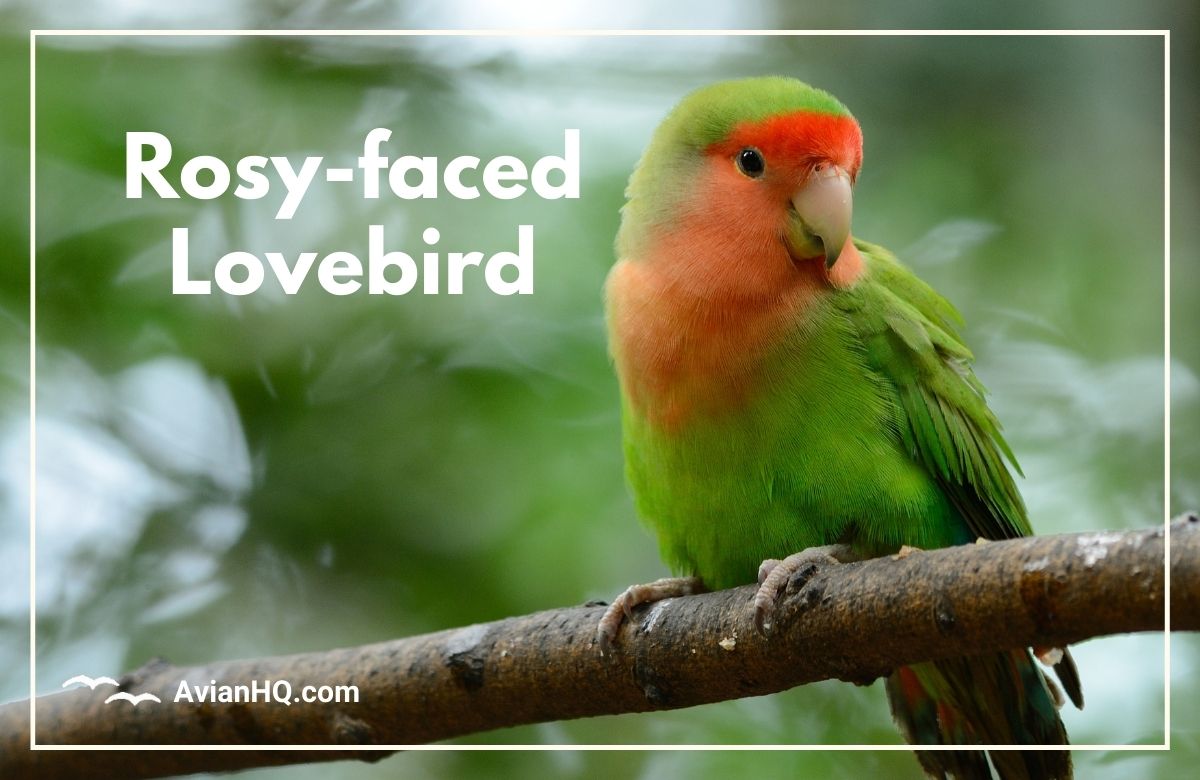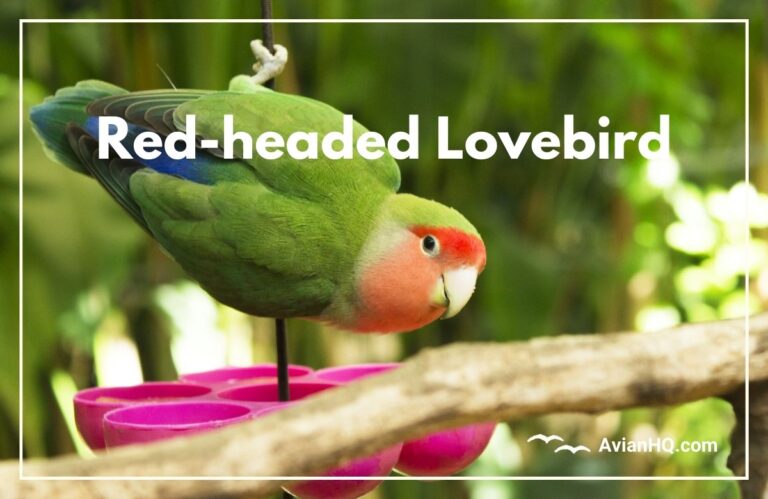Rosy-faced Lovebird (Agapornis roseicollis)
The vibrant Rosy-faced Lovebird is a small and delightfully colorful parrot native to the arid regions of southwestern Africa. With its bright green plumage accented by a pink face and throat, blue rump, and lively chattering calls, this petite bird has charmed its way into the hearts and homes of parrot enthusiasts around the world.
If you’ve ever admired one of these gems flitting around a pet store or envied a friend’s affectionate feathered companion, you’re not alone. Of all the lovebird species kept as pets, the Rosy-faced is one of the most popular.
In the wild, these social parrots gather in small, lively flocks between 5 to 20 individuals or sometimes upwards of 100 birds. But despite their bright colors belying a fierce spirit, Rosy-faced Lovebirds have faced trapping pressures from the pet trade in parts of their native range.
This comprehensive guide will cover everything you need to know if you’re considering bringing one of these characterful little parrots into your home. From their natural history, physical appearance, habits and disposition to their care requirements, learning about Rosy-faced Lovebirds beforehand is the best step to prepare for sharing your life with one.
We’ll discuss key topics in detail throughout the article such as:
- Rosy-faced Lovebird taxonomy and subspecies
- Size, weight, and visual differences
- Native habitats and introduced feral populations
- Diet, feeding behavior, and foraging adaptations
- Breeding ecology, nesting habits, and parental care dynamics
- Typical flocking behavior and vocal repertoires
- Conservation threats and legal protection status
- Tips for selecting and caring for Rosy-faced Lovebirds as pets
So whether you’re an experienced aviculturist or just fascinated by these endearing parrots, read on to learn more about the unique traits and behaviors of the Rosy-faced Lovebird.
History and Taxonomy
The vibrant little Rosy-faced Lovebird was first described scientifically in 1818 by the French ornithologist Louis Pierre Vieillot, who assigned it the binomial name Psittacus roseicollis. This name translates to “pink-necked parrot,” an apt description of its most striking feature.
In 2014, the species was reclassified into the genus Agapornis, which contains all the other lovebird species. Its current full scientific name is therefore Agapornis roseicollis.
Two subspecies of the Rosy-faced Lovebird are recognized:
- A. r. roseicollis: The nominate subspecies found across Namibia, Botswana, and South Africa
- A. r. catumbella: Native to southwestern Angola
These subspecies have slightly different coloration on their facial masks, which we’ll explore further in the next section. They also occupy geographically separated ranges mostly divided by the Angola/Namibia border.
So while they diverged into distinct populations long ago, Rosy-faced Lovebirds across southern Africa share common bonds in their appearance, habits, and origins on that diverse continent.
Physical Appearance
The Rosy-faced Lovebird is a diminutive parrot measuring around 6-7 inches (15-18 cm) long with an average weight of 1.6-2.2 ounces (46-63 grams). Like other lovebirds, it has a short blunt tail and a generally rounded, compact body shape.
Its plumage is primarily a vibrant green across the back, wings, tail, thighs, and underside. This verdant hue contrasts beautifully with a bright blue rump and upper tail coverts. The most distinctive feature lending the species its name is the adult’s pink facial mask, which extends from the forehead down through the eyes and cheeks to the upper breast.
The facial pink is deepest and darkest on the forehead and above the eyes. The area directly below the eyes has a slightly more orange or peach shade. The undertail is also tinged with orange-red.
The bill of adult Rosy-faced Lovebirds is a light horn color, the eyes are dark brown, and the legs and feet are gray. Juveniles have some subtle differences including a pale greenish crown, less vibrant facial hues washed with blue-gray, and a bill with a brownish-black base.
The two subspecies show slightly different facial coloration too. A. r. roseicollis has a bright red patch starting above its eyes, while A. r. catumbella has more extensive and deeper red hues extending across its cheeks.
No matter their age or subspecies though, Rosy-faced Lovebirds are truly aptly named thanks to their beautiful pink “masks.”
Habitat and Distribution
The Rosy-faced Lovebird occupies the arid environments of southwestern Africa across parts of Namibia, Botswana, South Africa, and Angola.
Its range extends from the Namib Desert through grassland and savanna habitats. It is found at elevations up to 5,200 feet (1,600 meters) above sea level. This range lies mainly inland, centered around 100-400 miles from the southwestern coast.
Within this dry landscape, Rosy-faced Lovebirds seek out two key features – food sources and water. So they predominantly live in areas with good tree or shrub cover near rivers or other water bodies. Open woodlands, riverine forests, agricultural lands, and semi-desert scrub provide ideal habitat.
They roost and nest in cavities in trees, termite mounds, crevices among rocks, or even manmade structures. Access to water for drinking and bathing daily is also vital, as Rosy-faced Lovebirds will readily gather at pools and waterholes in large numbers.
In recent decades, the pet trade has facilitated escaped and released Rosy-faced Lovebirds establishing feral breeding populations in certain cities with similar hot, arid climates. Major introduced populations are now found in Phoenix, Tucson, and other Arizona locales, as well as Hawaii.
So while most wild Rosy-faced Lovebirds reside innately in southern Africa, small adventurous flocks have succeeded at spreading their wings to distant new habitats too!
Diet and Feeding
In the wild, Rosy-faced Lovebirds are mainly granivorous, feeding on a variety of grass seeds that are abundant across their arid habitat. Their favored natural foods include native grasses, flowering plants, shrubs, and trees that produce small, oil-rich seeds capable of sustaining them in dry environments.
Key dietary staples consist of seeds from acacia, alibizia, mopane, and other trees and shrubs. They also regularly supplement with additional protein, carbohydrates, fruits, and vegetation. Buds, fruits, berries, vegetable matter, blossoms, and leafy greens are avidly consumed when available.
Rosy-faced Lovebirds spend a large portion of their day actively foraging and feeding on this mixed diet. They feed opportunistically on whichever food sources are most readily available in their habitat depending on the season. This may mean switching between grazing on grass seeds on the ground or clipping berries and leaves directly from bushes.
They drink frequently when water is available and conscientiously preen their feathers to stay neat and healthy. Rosy-faced lovebirds reside in small flocks of 5 to 20 birds year-round. But during times of abundance such as grass seed production, they may congregate in large groups called “roosts” of over 100 birds. This strategy helps them efficiently exploit and share plentiful resources.
In captivity as pets or aviary birds, the typical Rosy-faced Lovebird diet aims to mimic their diverse natural cuisine, focused on a quality seed mix supplemented with vegetables, fruits, pellets, and protein sources. Providing enrichment through fresh branches, sprouts, and foraging toys also helps satisfy their active behaviors.
Breeding and Reproduction
Rosy-faced Lovebirds reach sexual maturity by around 18 months old. They form strong pair bonds, often remaining monogamous for multiple years. Their breeding season spans late winter through spring, corresponding with seasonal rainfall patterns in their native southern hemisphere range.
For nesting, they seek out small protected cavities that offer shelter and seclusion. Preferred options include holes in trees, empty spaces in nests built by other birds like weaver species, or gaps and crevices among rocks, cliffs, and canyon walls. Rosy-faced Lovebirds also readily inhabit man-made nest boxes provided their cavity requirements are met.
Inside chosen nest sites, females construct nests out of sticks, stems, leaves, bark strips, and other plant material. They then lay clutches of 4 to 6 small round white eggs, which both parents help incubate over a period of 23 days.
Once hatched, Rosy-faced Lovebird chicks are cared for by their parents in the nest for about 6 weeks. They are totally dependent on parental feeding and protection until fledging between ages 43 to 44 days. By around 3 to 4 months old, the young are nearly fully feathered and confident flyers.
Interestingly, Rosy-faced Lovebird females have specialized “carrying feathers” on their tails. They can tuck long pieces of nest material like bark, stems, or grasses into these feathers, then transport them back to furnish their nest. This efficient, ingenious technique is unique to breeding female Rosy-faced Lovebirds among parrots. It’s one more example of the amazing adaptations and behaviors exhibited by these captivating birds!
Behavior and Ecology
Rosy-faced Lovebirds are highly social birds that live in small flocks year-round, roosting and foraging together. Their groups typically range from 5 to 20 individuals in size. But during abundant seasons, they may congregate in large communal roosts over 100 strong at prime habitat locations.
They are vocal birds, using a diversity of loud, shrill calls to communicate within their flock. Different chirping, screeching, and contact calls help coordinate their movements, share information about threats or food sources, and mediate conflicts. Their chatter provides constant background noise enlivening their habitat.
Agile flyers capable of rapid maneuverability, Rosy-faced Lovebirds spend much of their day on the wing – flying out from roosts to forage across their home territory, socializing among canopy perches, or visiting waterholes. They roost communally each night, huddling closely side-by-side on branches for warmth and protection.
These social bonds extend across flocks as well. It’s not uncommon for multiple small groups to intermingle around prime foraging grounds, water sources, or mineral licks. But they show loyalty to their own group when separating to roost in traditional sites.
Rosy-faced Lovebirds bathe frequently whenever possible by wading into pools or splashing water over their bodies. Their feather density and preening behaviors help them stay neat and clean.
They can be aggressive in defending collective territory or food resources, embroiling in squabbles with other groups of lovebirds. And they may mob or drive off larger bird species seen as threats. But they ultimately thrive on their sociality and group behaviors. Their innate need for company ensures Rosy-faced Lovebirds naturally reside in bustling, lively flocks.
Conservation Status
Rosy-faced Lovebirds are currently classified as Least Concern on the IUCN Red List of Threatened Species. This means they remain relatively widespread and abundant within major portions of their native range. Total population sizes have not been quantified but are presumed large enough to not yet trigger immediate extinction risk.
However, their numbers have decreased in certain areas like southwest Angola due to ongoing captures for the wild bird trade. Tens of thousands of Rosy-faced Lovebirds were exported from Africa for the pet industry during the late 20th century. This pressure persists today alongside habitat losses.
In Namibia, habitat protection within reserves and reduced trapping has allowed some recovery. But across Africa, competition for nesting sites and resources from other increasingly common bird species poses mounting concerns for conservation.
Several international commercial trade restrictions have been enacted to curb unsustainable wild bird extractions. Yet poaching and illegal capture of Rosy-faced Lovebirds continues in many regions. More research, updated population surveys, active enforcement, and expanded habitat conservation will be vital to ensure the long-term survival of this special parrot in its native home.
Meanwhile feral introduced populations are flourishing in parts of Arizona and Hawaii. These escaped pets and their descendants appear to be maintaining self-sustaining wild Rosy-faced Lovebird flocks. So even if threats intensify in Africa, vibrant little “wild” colonies seem likely to persist in their new territories abroad!
Conclusion
The delightful Rosy-faced Lovebird has earned its place as one of the most widely admired and popular small parrots kept in captivity globally. Its petite stature houses a huge personality – conveying affection, charm, beauty, and intelligence through expressive eyes that peer out from a colorful feathery visage.
This inherent appeal comes packaged with responsibility for any prospective owner though. We must strive to understand the behaviors and needs of this active, social species before welcoming one into our lives. Proper housing, enrichment, nutrition, and veterinary care are paramount for their health and happiness.
And when sourcing a Rosy-faced Lovebird, always insist on an aviary-raised and hand-fed baby bird to start building a rewarding relationship. Support ethical breeders focused on best practices, not wild-caught pet trade imports that threaten conservation.
In the wild, while Rosy-faced Lovebird populations still number in the millions, their futures in those arid southern African habitats face some uncertainty from trapping and encroaching pressures. Carefully regulated and sustainable harvesting is possible with improved oversight.
But further field research and conservation action will be key to preserve Rosy-faced Lovebirds across their native ranges over the long term. The vibrance and affection these feisty parrots provide, whether in nature or our homes, should continue charming the world for generations to come through conscientious stewardship.
If managed properly, the beloved Rosy-faced Lovebird’s outlook remains bright wherever they fly free!







